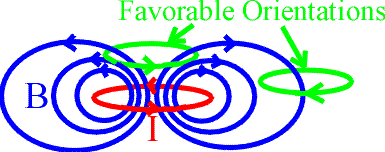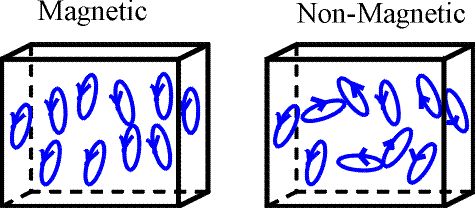
Magnetic, non-magnetic, ferromagnetic....
Many atoms have electrons which are able to rotate any way they please. These rotating electrons are the dipoles which both create and respond to magnetic fields. Consider the magnetic field of the red dipole shown below.

A second dipole, shown in green will find it energetically favorable to line up in the same direction as the red dipole if it is placed directly above it, but will find it favorable to line up opposite to the dipole if it is place to the side. The study of properites is therefore a rather complex subject.
There are a variety of classifications of magnetic materials.

Here we list three such classifications.
Magnetic: These materials have their moments coordinated such that they point in the same direction. They therefore produce strong magnetic fields.
Non-magnetic: Such substances have little reaction to magnetic fields. They may be composed of molecules where electrons spinning one way are always balanced by electrons spinning the other, or their spins may simply interact only weakly.
Ferromagnetic: These materials would like to be magnetic, except that the thermal motion keeps them from acting collectively. However, the dipoles are easily coaxed into lining up together by the magnetic field of another object.